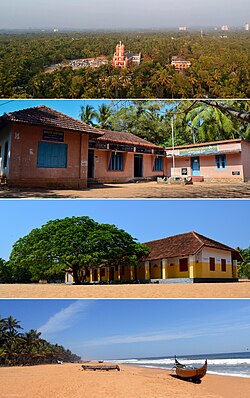Puthenthope
|
Puthenthope പുത്തൻതോപ്പ് |
|
|---|---|
| Village | |

Clockwise from top : Puthenthope, Jaihind Vayanasala, St Ignatius UP School, Puthenthope Beach, St Ignatius Church
|
|
| Location in Kerala, India | |
| Coordinates: 8°34′23″N 76°50′12″E / 8.57306°N 76.83667°ECoordinates: 8°34′23″N 76°50′12″E / 8.57306°N 76.83667°E | |
| Country |
|
| State | Kerala |
| District | Thiruvananthapuram |
| Government | |
| • Body | Gram panchayat |
| Languages | |
| • Official | Malayalam, English |
| Time zone | IST (UTC+5:30) |
| PIN | 695586 |
| Vehicle registration | KL-22 |
| Nearest city | Thiruvananthapuram |
| Lok Sabha constituency | Attingal |
| Climate | Hot and Humid (Köppen) |
Puthenthope (Puthen - New, Thope - Orchard) is a coastal village in Thiruvananthapuram (Trivandrum) district in Kerala, India, and situated 19 km northwest of City centre, 16 km from Trivandrum International Airport. The village is mostly covered with coconut palms and cashew trees. Its western side edges the Arabian sea, while the east is separated by Parvathi Puthanar, a manmade canal completed during the time of Regent Sethu Lakshmi Bhai of Travancore Kingdom. Access to National Highway (NH 47) and a railway station is as short as 2 km and the VSSC of the Indian Space Research Organisation is close by. There are two man made hills — one on the south (Thekkekkunnu)and the other on the north (Vadakkekkunnu), which are believed to have been made during the time of Portuguese. Most famous personality from Puthenthope is theatre film actor Allensiar of Maheshinte Prethikaram fame
There is little written historical record of Puthenthope's development but a strong oral tradition.
In the 15th century, the Portuguese were looking for a strategic point to place their cannons, aiming at the Dutch ship movements in the Arabian Sea. They found a suitable place with tall coconut palms on the coastal area and dense forest throughout the inland. If they could build hills in between and place the cannons there, the ships could not see it but the people in the land could easily monitor. So to build the hills, Portuguese brought a group of Kusavans (potters) from Ambalappuzha, a place in the present Alappuzha district. They made the hills for the cannons to be placed. The Kusavans who came from Amplapuzha stayed back and continued with their occupation of pot making. The occupation of pot making was not suitable for many reasons–the unavailability of clay, the long walk through the forest to the nearest market, presence of notorious thieves on the forest way etc. They turned to another profitable occupation–fishing.
...
Wikipedia


